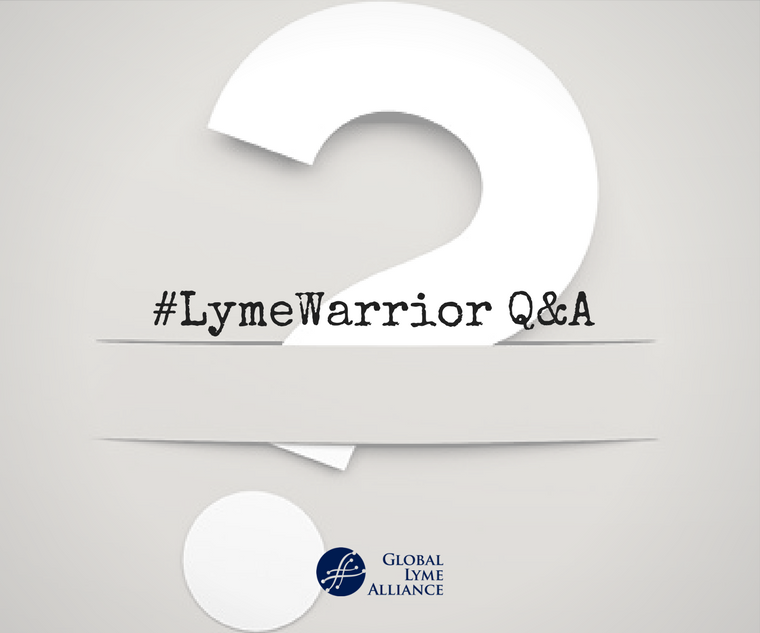
by Jennifer Crystal
Every few months, Jennifer Crystal devotes a column to answering your questions. Here are her answers to questions she has recently received. Do you have a question for Jennifer? Email her at jennifercrystalwriter@gmail.com.
I found a rash, but it wasn’t a bull’s-eye. Should I be worried about Lyme disease?
Yes. You should be evaluated not just for Lyme but for other tick-borne illnesses as well. Lyme disease rashes, known as Erythema Migrans (EM), can present in many different forms and can migrate to different parts of the body months or even years after infection. My initial EM rash was a series of red dots on the inside of my right forearm. When I discovered it at sleep-away camp, the nurse brushed it off as nothing. Had either of us been Lyme-literate, we would have known that I should have immediately been tested for tick-borne disease, especially when I developed hypoglycemia and flu-like symptoms shortly thereafter.
But consider yourself lucky, for while a rash is a telltale sign of Lyme, less than 50% of patients ever get or see one. If you find any type of rash and think you might have been bitten by a tick—or if you have symptoms of tick-borne illnesses—you should see a Lyme Literate Medical Doctor (LLMD) for a clinical evaluation at once. If I’d done so two decades ago, I might have avoided enormous suffering.
I’ve heard of the “Lyme diet.” Does it really make a difference to stick to a special diet when you have a tick-borne illness?
For me, it’s made a big difference. I started a gluten-free, sugar-free diet before I was accurately diagnosed with Lyme and its co-infections babesia, and Ehrlichia. A naturopathic physician had recommended I do so as part of treatment for Epstein Barr virus, which I was also battling. Gluten and sugar can both lead to intestinal yeast overgrowth, which can weaken the immune system.
Once I was diagnosed with three separate tick-borne diseases, it became even more important to stick to the diet. Yeast and sugar can speed up the reproduction of the tick-borne bacteria and exacerbate inflammation in the body. Eliminating—or at least significantly reducing—these foods has allowed me to stay on oral antibiotics for long periods without issues (I also take essential probiotics). I don’t consume alcohol or caffeine. Some people find that eliminating dairy also helps; this only seems to make a difference for me personally if I’m battling an upper respiratory infection. You might try eliminating these foods one at a time to see how you feel. If you stop eating everything all at once, you won’t really know which of the foods is the culprit. Think of it like a science experiment: you can’t have too many variables.
Once you know what foods are best for you to eliminate or reduce, the key is moderation. For three years I stuck so strictly to the gluten-free, sugar-free diet that I refused to even take a bite of chocolate. But how was I going to get well without my favorite food? My doctor helped me to see the bigger picture. He reminded me that dark chocolate is very low in sugar. So I now have one small piece of dark chocolate every day, and on special occasions, I have gluten-free brownies or ice cream sweetened with molasses or agave nectar. If I ate those treats every day, I’d still have a sugar problem, but having them once in a while—and then otherwise sticking to my usual diet, which is full of complex carbohydrates, lean proteins, and lots of fruits and vegetables—keeps me in good shape.
Did you ever suffer from sleep paralysis? If so, what helped?
Yes, and it was so scary because I didn’t know what was happening to me. Sleep paralysis is when the brain wakes up before the body, and the body cannot move. It can be caused by severe sleep deprivation, a common symptom of Lyme disease, and can also be a sign of neurological impairment brought on by tick-borne illness.
I would sometimes dream that I was awake, trying to move my legs and get out of bed, but when I did really wake up, I couldn’t do those things. Other times I’d wake up feeling like my blood was no longer circulating through my body; my limbs were like dead weight against the sheets, and I sensed that my head was being drawn back into the pillow. I’d try with all my might to lift my head; in my panicked state, I thought that if I didn’t, I would slip into a coma.
That never happened, and my body always did eventually wake up. Usually, sleep paralysis subsides in a few minutes. Once my doctor explained the condition to me, I was less fearful when it did happen. It got much better once I started getting more restorative sleep, which I achieved through a combination of pharmaceutical medication, nutritional supplements, cognitive behavioral therapy, and neurofeedback. What helped the most though was getting the Lyme bacteria out of my brain; once I’d been on antibiotics long enough, sleep also improved.
Even now, in remission, I sometimes get sleep paralysis when I’m extremely tired. This is a sign to me that I’ve pushed my body too far and I need to slow down. Scary as sleep paralysis is, I’m grateful to my body for giving me a signal to rest.
 Opinions expressed by contributors are their own.
Opinions expressed by contributors are their own.
Jennifer Crystal is a writer and educator in Boston. She is working on a memoir about her journey with chronic tick-borne illness. Contact her at jennifercrystalwriter@gmail.com

GLA
Admin at GLA






-2.jpg)